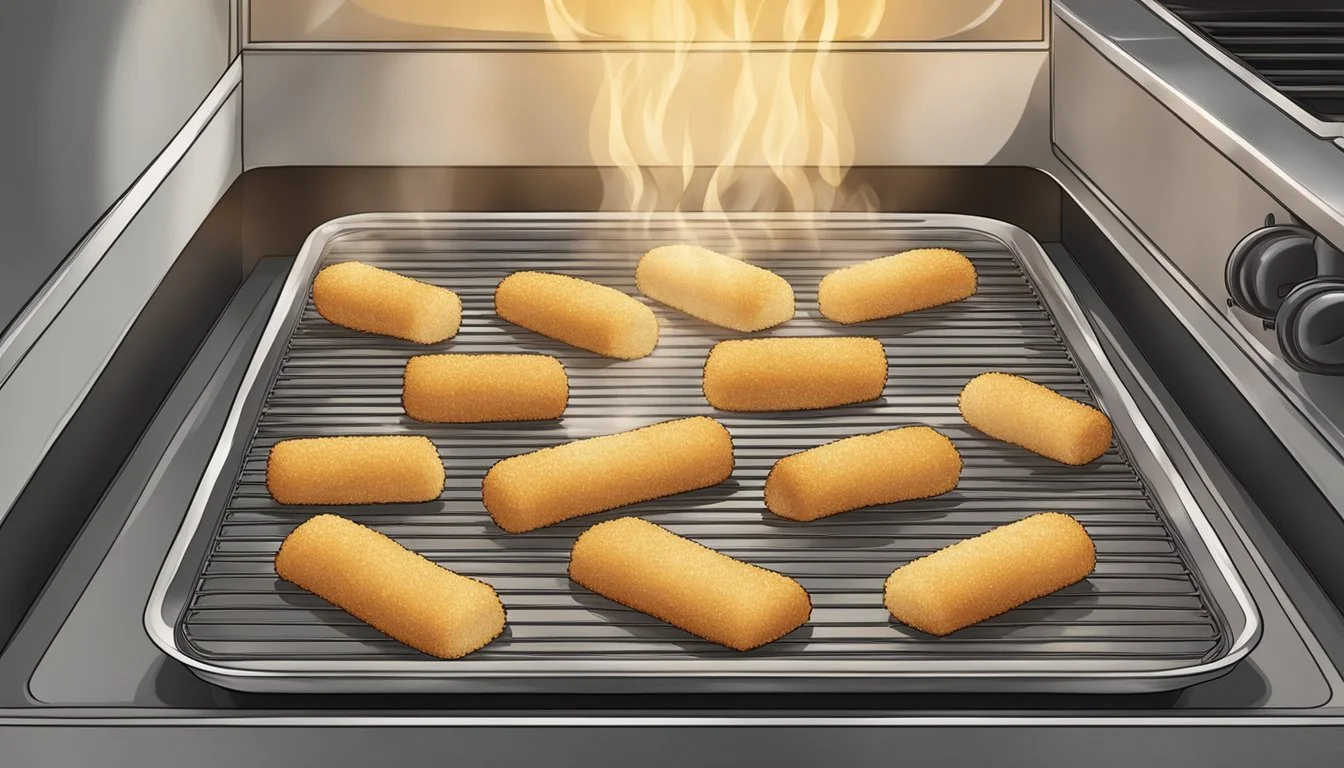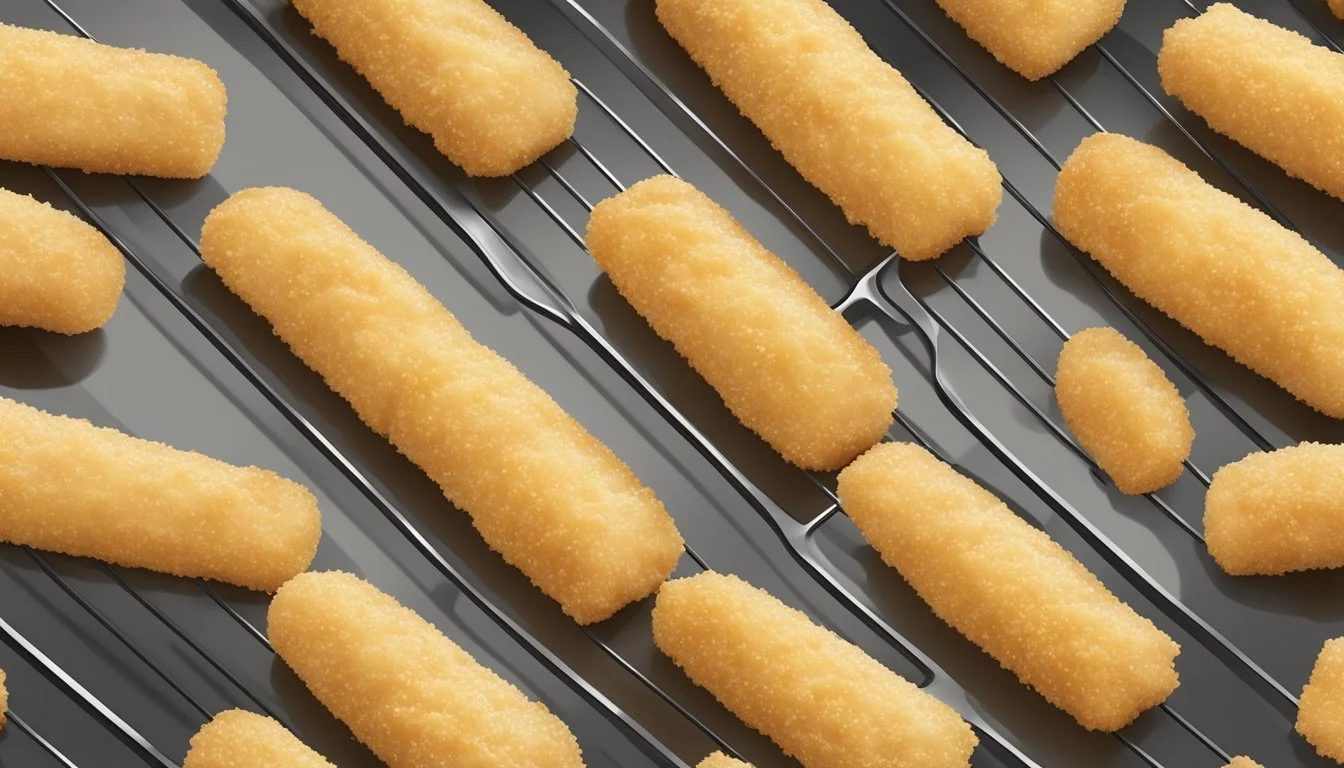How to Reheat Gluten-Free Mozzarella Sticks
Best Methods for Perfect Results
Reheating gluten-free mozzarella sticks doesn't have to be a challenge. To enjoy crispy, gooey mozzarella sticks that taste freshly made, reheating them properly is key. Whether you store leftovers in the fridge or freeze them for later, using an air fryer or toaster oven ensures they come out perfect every time.
For the best results, preheat your air fryer to 400°F and arrange the mozzarella sticks without overlapping. Heat them for up to 8 minutes, flipping them halfway through. This method guarantees a crispy exterior and melty cheese inside, making them a great option for a quick snack or appetizer.
If you prefer using a toaster oven, set it to a similar temperature and keep an eye on the sticks as they reheat for about three minutes. This method also works well to bring back their crunch and flavor. No more soggy leftovers—just delicious, gluten-free mozzarella sticks every time.
Understanding Gluten-Free Mozzarella Sticks
Gluten-free mozzarella sticks require careful selection of ingredients and techniques to ensure they remain crispy and delicious while accommodating gluten sensitivities.
Ingredients and Alternatives
The primary ingredient in gluten-free mozzarella sticks is mozzarella cheese. It's crucial to use high-quality, firm mozzarella to prevent excessive melting during cooking.
Common Ingredients:
Mozzarella Cheese: Full-fat or part-skim varieties.
Gluten-Free Flour: Often made from rice, potato starch, or tapioca.
Seasonings: Italian seasoning, garlic powder, salt, and pepper.
Eggs: Used for coating.
Parmesan Cheese: Adds extra flavor.
Alternatives to Consider:
Almond Flour: A popular low-carb option.
Oat Flour: Offers a different texture and flavor.
Nutritional Yeast: Can provide a cheesy flavor for a dairy-free option.
Gluten-Free Breading Techniques
Creating a crispy, gluten-free breading requires a few essential steps.
Steps for Breading:
Flour Mix: Start with a blend of gluten-free flour and seasonings. This layer helps the egg coating adhere to the cheese.
Egg Wash: Beat eggs in a bowl to create a sticky surface for breadcrumbs.
Bread Crumbs: Use gluten-free bread crumbs or a mix of almond flour and Parmesan for added crispiness.
Tips:
Double Coating: Dip the mozzarella in flour, then egg, and finally breadcrumbs. Re-dip in egg and breadcrumbs for extra crispiness.
Freezing: Freeze the coated sticks for at least two hours to firm up before cooking. This step helps maintain their shape and prevents excessive melting.
Preparing Mozzarella Sticks for Reheating
Proper preparation is crucial for successfully reheating gluten-free mozzarella sticks. This guide will walk you through freezing and storage tips, assembly line preparation, and optimal freezing techniques.
Freezing and Storage Tips
For optimal results, freeze mozzarella sticks individually on a baking sheet before storing them. This prevents them from sticking together.
Storage: Use airtight containers or freezer bags to maintain freshness and prevent freezer burn. Ensure each stick is well-coated with breadcrumb mixture before freezing.
Labeling is important. Mark containers with the date and contents, so you know how long they've been in the freezer.
Shelf Life: Gluten-free mozzarella sticks can be stored for up to two months.
Assembly Line Preparation
Having an efficient assembly line speeds up the process of preparing mozzarella sticks for freezing.
Steps:
Set up three bowls: one with gluten-free flour, one with beaten eggs, and one with gluten-free breadcrumbs.
Dip each stick: Start with flour, then egg, and finally breadcrumbs.
Repeat the coating process: Double-coating each stick improves the texture when fried or baked.
Efficiency: Prepare all sticks to be breaded at once, then move to the next step. This helps reduce time and keeps the kitchen organized.
Optimal Freezing Techniques
Flash freezing is the best method to ensure each mozzarella stick remains separate and easy to reheat.
Process: Place the breaded sticks on a baking sheet in a single layer. Freeze them for 1-2 hours until solid.
Final Storage: Once frozen solid, transfer the sticks to an airtight container or freezer bag. This method ensures they don't stick together.
Spacing: Leave some space between the sticks on the baking sheet to prevent them from freezing into a lump.
Following these steps will make reheating your gluten-free mozzarella sticks a breeze. Proper preparation ensures they retain their quality and taste.
Reheating Methods
Reheating gluten-free mozzarella sticks can be done using an oven, air fryer, or a frying pan. Each method ensures that the sticks stay crispy on the outside while keeping the cheesy goodness inside gooey and delicious.
Oven Reheating
Using the oven to reheat gluten-free mozzarella sticks is a reliable way to maintain their crispy texture.
Preheat the oven to 375°F (190°C).
Place the mozzarella sticks on a baking sheet, making sure they are evenly spaced out.
Bake them for 10-12 minutes, checking occasionally to ensure they don't overcook.
This method ensures even heating and can handle a larger batch compared to other methods. Watch closely for a golden-brown color to know they're ready.
Air Fryer Reheating
The air fryer is an excellent choice for reheating mozzarella sticks, providing a quick and efficient way to achieve a crunchy exterior.
Preheat the air fryer to 350°F (175°C) for about three minutes.
Lightly spray the mozzarella sticks with nonstick cooking spray.
Place them in the air fryer basket or tray, ensuring they don't touch.
Cook for 3 minutes, then turn them over and cook for an additional minute or two.
Air frying helps retain the crispy texture without needing too much oil.
Frying Pan Reheating
Reheating in a frying pan can also provide a crisp texture similar to the original cooking method.
Heat a thin layer of oil in a frying pan over medium heat.
Once the oil is hot, add the mozzarella sticks, spacing them out so they are not crowded.
Fry for 1-2 minutes on each side until they are crispy.
This method requires a bit more attention but ensures the exterior stays crunchy while the interior remains gooey and cheesy.
Ensuring Optimal Texture and Flavor
Achieving the perfect crispy and gooey balance in gluten-free mozzarella sticks requires attention to both reheating techniques and seasoning. By mastering these methods, you can ensure your mozzarella sticks have an irresistible texture and flavor.
The Double Dip Technique
The double dip technique enhances the crunchiness of gluten-free mozzarella sticks. Start by preparing a coating station with gluten-free flour, beaten egg, and a seasoned breadcrumb mixture. For extra crunch, use almond flour or crushed gluten-free crackers.
Dip each mozzarella stick first in the flour to create a base layer. Then, dip it in the beaten egg, ensuring an even coating. Roll the stick in the seasoned breadcrumb mixture, pressing to adhere.
Repeat the egg and breadcrumb steps to develop a thicker crust that resists moisture and stays crispy during reheating. Using this method ensures the mozzarella sticks remain crunchy on the outside while maintaining a gooey, melted cheese center.
Seasoning Mixtures
Seasoning enhances the flavor of mozzarella sticks, and a good mixture can make them unforgettable. Start with salt, the primary seasoning. Combine it with garlic powder, black pepper, and Italian seasoning for a classic taste.
Italian seasoning typically includes oregano, parsley, and basil, which complement the cheese. For a bit of heat, add a pinch of paprika.
Mix the spices well before adding them to the breadcrumb mixture. This ensures an even distribution of flavors across the mozzarella sticks. Balancing the seasonings will give each bite a delicious, well-rounded taste, making your gluten-free mozzarella sticks stand out.
Dipping Sauces and Pairings
Pairing gluten-free mozzarella sticks with the right dipping sauces can elevate the snacking experience. From classic marinara to more creative options, each sauce brings out unique flavors.
Classic Marinara Sauce
Marinara sauce is a timeless dip for mozzarella sticks. Its tangy, rich tomato base complements the milky mozzarella effectively. Ingredients typically include tomatoes, garlic, onions, and a blend of herbs.
Prepare marinara by simmering canned tomatoes with minced garlic and onions. Add basil, oregano, and a touch of olive oil.
For a richer flavor, include a dash of red wine or balsamic vinegar.
Serve warm to ensure a pleasant, cohesive bite with the crispy, melted mozzarella. This pairing is great to enjoy at gatherings or as a simple snack.
Creative Sauce Options
For those looking to experiment, ranch dressing is a popular alternative. Its creamy texture and subtle herbs provide a contrast to the crunchy exterior.
Garlic aioli is another excellent choice. This sauce, a blend of garlic and mayonnaise, adds a robust, savory flavor.
Pesto, with its fresh basil, garlic, pine nuts, and Parmesan cheese, offers a unique, herbal note that pairs excellently with cheese. Each of these sauces can be homemade or store-bought.
These creative options allow for versatility and cater to various taste preferences, making them ideal for diverse palettes.
Tips for the Perfect Gluten-Free Mozzarella Sticks
Perfecting gluten-free mozzarella sticks requires careful preparation and attention to detail. Key considerations include maintaining strict gluten-free practices and addressing common issues that may arise during the cooking process.
Maintaining Safe Gluten-Free Practices
One of the most critical aspects of preparing gluten-free mozzarella sticks is to ensure that all ingredients and utensils are free from gluten contamination. Only use gluten-free labeled ingredients such as gluten-free flour blends and seasonings.
When preparing the sticks, use separate utensils and cooking areas to avoid cross-contamination. Wash hands, cutting boards, and any other surfaces thoroughly before they come into contact with gluten-free ingredients.
For deep-frying, change the oil if it has previously been used to fry gluten-containing foods. If using an air fryer, clean the basket thoroughly before each use to eliminate any gluten traces. These steps are vital to maintaining an allergy-friendly cooking environment.
Troubleshooting Common Issues
Ensuring gluten-free mozzarella sticks turn out perfectly can sometimes be challenging. If the sticks break apart while cooking, freeze them longer before frying or baking. A two-hour minimum freezing time usually helps maintain their shape during the cooking process.
If the coating doesn't adhere properly, double-coat the sticks: dip them in the egg mixture, then the flour mixture, and repeat. This additional layer helps the coating stick better, especially when using gluten-free ingredients.
Sometimes gluten-free mozzarella sticks may not brown evenly. For an air fryer, spray the sticks lightly with oil to achieve a more even golden color. Monitor the cooking temperatures closely; for frying, maintain a temperature of around 350°F to 365°F, and for baking, preheat the oven to 400°F.
Following these tips can help address common issues and result in delicious homemade gluten-free mozzarella sticks every time.
Serving and Presentation
When serving gluten-free mozzarella sticks, consider both the aesthetic appeal and pairing them with complementary main courses.
Plating for Gatherings
For gatherings, arrange mozzarella sticks on a large platter. Use a circular or fanned-out pattern to make them visually appealing. Garnish with fresh herbs like parsley or basil for a touch of color. Serve with dipping sauces such as marinara, ranch, or garlic aioli in small bowls.
Provide toothpicks or appetizer forks to allow guests to effortlessly pick up the sticks. This setup is ideal for game day snacks or casual get-togethers, making it easy for guests to enjoy without utensils.
Pairing with Main Courses
Pair gluten-free mozzarella sticks with main courses to complement Italian dishes or light meals. Serve alongside spaghetti and meatballs, grilled chicken, or a fresh garden salad. Position the mozzarella sticks on the same plate or on a side dish, ensuring they remain crisp.
For a more balanced meal, add a side of roasted vegetables or a small portion of quinoa. This creates a well-rounded dinner while highlighting the mozzarella sticks as a delightful addition.
Special Dietary Considerations
When reheating gluten-free mozzarella sticks, it's important to consider various dietary needs such as dairy-free and allergy-friendly options. Selecting the right ingredients ensures everyone can enjoy this delicious snack.
Alternative Ingredient Options
For those with dairy allergies, dairy-free mozzarella sticks can be made using a plant-based cheese alternative. Ensure the cheese used is both dairy-free and melts well to achieve the gooey center that characterizes mozzarella sticks.
Incorporating allergy-friendly ingredients is crucial. Choose a gluten-free flour blend that avoids common allergens like nuts, dairy, and soy. Many gluten-free flours are made from rice, tapioca, or potato starch which cater to multiple dietary restrictions.
Consider oil sprays or cooking methods that also account for allergies. Avocado oil spray or coconut oil spray are good options for those avoiding allergens typically found in more processed non-stick sprays.
Related Gluten-Free Snack Ideas
Exploring other gluten-free snacks that complement gluten-free mozzarella sticks can add variety and excitement to a snack repertoire. Options like gluten-free onion rings, vegetable-based snacks, and homemade cheese alternatives offer delicious choices for those avoiding gluten.
Gluten-Free Onion Rings
Gluten-free onion rings make a great companion to gluten-free mozzarella sticks. They are made by slicing onions into rings, coating them in a gluten-free flour blend, and then frying them until crispy.
Using a mixture of gluten-free flour, almond flour, or a premade gluten-free breadcrumb mix ensures that the coating is both crispy and flavorful. Popular seasonings include garlic powder, paprika, salt, and pepper. The onion rings can be fried in oil or air-fried for a healthier option.
Vegetable-Based Snack Varieties
Vegetable-based snacks like zucchini fries and sweet potato chips offer nutritious alternatives for gluten-free snacking. Zucchini fries can be made by cutting zucchini into sticks, coating them in a gluten-free flour mixture, and baking or air-frying.
Sweet potato chips involve thinly slicing sweet potatoes, lightly brushing them with olive oil, and baking until crispy. These snacks can be seasoned with sea salt, black pepper, and paprika for added flavor. Kale chips are another popular option, providing a crunchy, low-calorie treat.
Homemade Cheese Alternatives
For cheese lovers, homemade cheese snacks, such as gluten-free mozzarella sticks, offer a straightforward way to enjoy gluten-free cheese. They are typically made by coating mozzarella sticks in a gluten-free flour blend and then frying or baking until golden.
Another option is to create cheesy bites using a mixture of cheddar and parmesan, which can be shaped into small balls, coated, and baked. These cheese alternatives can be seasoned with Italian herbs, garlic powder, and other spices to enhance their flavor. Using gluten-free ingredients like almond flour or gluten-free breadcrumbs ensures that these snacks are safe for those with gluten sensitivities.







